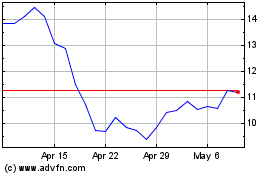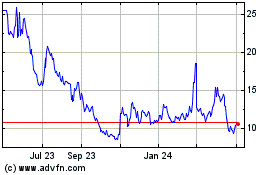- Stimulating gene editing by homology-directed
repair (HDR) has the potential advantage of being able to achieve
any type of edit, including gene insertion
- ARCUS approach potentially offers broader
therapeutic than current gene editing modalities for diseases that
require a gain in function
Precision BioSciences, Inc. (Nasdaq: DTIL), a clinical stage
gene editing company utilizing its novel proprietary ARCUS®
platform to develop in vivo gene editing therapies for
sophisticated gene edits, today announced a poster presentation at
the European Society of Gene & Cell Therapy (ESGCT) 31st Annual
Congress being held October 22-25, 2024, in Rome, Italy. The poster
highlighted preclinical data demonstrating the ability of ARCUS to
achieve high-efficiency gene insertion, gene replacement and base
correction via homology-directed repair (HDR).
“Gene editing enzymes that support efficient HDR are relatively
rare. However, we demonstrate here that ARCUS is capable of
utilizing HDR with high efficiency to achieve a range of gene
editing outcomes, including specific base changes, insertions, and
the replacement of large segments of DNA within the genome," said
Jeff Smith, PhD, Co-Founder and Chief Research Officer of Precision
BioSciences. “These data continue to validate the ARCUS platform as
an ideal modality for treating diseases that require gene insertion
or repair to restore function whereas other gene editing modalities
are largely focused on knocking-out function. In addition to the
preclinical data presented today, we look forward to seeing
supportive clinical validation of HDR-based ARCUS gene insertion
through our partner iECURE, who is advancing their ECUR-506
clinical stage program utilizing an ARCUS nuclease for treating OTC
deficiency,” added Jeff Smith.
Title: High-efficiency homology-directed insertion into
the genome using ARCUS nucleases Poster Number: #PO678
Presenter: Adam Mischler, PhD, Senior Scientist, Precision
BioSciences Gene Discovery Date and Time: Thursday, October
24, 2024, 6:00-7:30pm CEST
In preclinical work presented today, we show that targeted gene
insertion can be achieved using ARCUS in greater than 85% of T
cells and 39% of non-dividing primary human hepatocytes. These high
rates of gene insertion were accomplished primarily through HDR as
evidenced by the dependency on homology arms in the repair template
and on the unique ARCUS 3’ 4 base pair overhang cut that resembles
a processed end for stimulating HDR. Using HDR, ARCUS successfully
demonstrates the ability to support a wide range of DNA editing
approaches using a template to define the specific edit. Unlike
base editors’ limitation to two possible base changes, ARCUS was
able to produce all twelve possible base changes, in addition to
producing very specific base removal and insertions. Unlike prime
editors, ARCUS was also able to generate whole gene insertions and
even replace large segments within a gene to restore function. The
characteristic enzymology of ARCUS nucleases drives high rates of
HDR, which can potentially be leveraged to achieve a multitude of
highly precise gene editing functions for therapeutic benefit.
About Precision BioSciences, Inc.
Precision BioSciences, Inc. is an advanced gene editing company
dedicated to improving life (DTIL) with its novel and proprietary
ARCUS genome editing platform that differs from other technologies
in the way it cuts, its smaller size, and its simpler structure.
Key capabilities and differentiating characteristics may enable
ARCUS nucleases to drive more intended, defined therapeutic
outcomes. Using ARCUS, the Company’s pipeline is comprised of in
vivo gene editing candidates designed to deliver lasting cures for
the broadest range of genetic and infectious diseases where no
adequate treatments exist. For more information about Precision
BioSciences, please visit www.precisionbiosciences.com.
The ARCUS platform is being used to develop in vivo gene editing
therapies for sophisticated gene edits, including gene insertion
(inserting DNA into a gene to cause expression/add function),
elimination (removing a genome, e.g., viral DNA or mutant
mitochondrial DNA), and excision (removing a large portion of a
defective gene by delivering two ARCUS nucleases in a single
AAV).
Forward-Looking Statements
This press release contains forward-looking statements within
the meaning of the Private Securities Litigation Reform Act of
1995. All statements contained in this press release that do not
relate to matters of historical fact should be considered
forward-looking statements, including, without limitation,
statements regarding the clinical development and expected safety,
efficacy and benefit of our product candidates and gene editing
approaches including editing efficiency, key capabilities and
differentiating characteristics, the ability of ARCUS to achieve
any type of edit including high-efficiency gene insertion, gene
replacement, and base correction, the ability of ARCUS to stimulate
gene editing by homology directed repair, the potentially broader
therapeutic potential of ARCUS for diseases that require a gain in
function than current gene editing modalities and the suitability
of ARCUS nucleases for gene elimination, insertion and excision and
differentiation from other gene editing approaches due to its small
size, simplicity and distinctive cut. In some cases, you can
identify forward-looking statements by terms such as “aim,”
“anticipate,” “approach,” “believe,” “contemplate,” “could,”
“designed,” “estimate,” “expect,” “goal,” “intend,” “look,” “may,”
“mission,” “plan,” “possible,” “potential,” “predict,” “project,”
“pursue,” “should,” “strive,” “target,” “will,” “would,” or the
negative thereof and similar words and expressions.
Forward-looking statements are based on management’s current
expectations, beliefs and assumptions and on information currently
available to us. These statements are neither promises nor
guarantees, and involve a number of known and unknown risks,
uncertainties and assumptions, and actual results may differ
materially from those expressed or implied in the forward-looking
statements due to various important factors, including, but not
limited to, our ability to become profitable; our ability to
procure sufficient funding to advance our programs; risks
associated with our capital requirements, anticipated cash runway,
requirements under our current debt instruments and effects of
restrictions thereunder, including our ability to raise additional
capital due to market conditions and/or our market capitalization;
our operating expenses and our ability to predict what those
expenses will be; our limited operating history; the progression
and success of our programs and product candidates in which we
expend our resources; our limited ability or inability to assess
the safety and efficacy of our product candidates; the risk that
other genome-editing technologies may provide significant
advantages over our ARCUS technology; our dependence on our ARCUS
technology; the initiation, cost, timing, progress, achievement of
milestones and results of research and development activities and
preclinical and clinical studies, including clinical trial and
investigational new drug applications; public perception about
genome editing technology and its applications; competition in the
genome editing, biopharmaceutical, and biotechnology fields; our or
our collaborators’ or other licensees’ ability to identify, develop
and commercialize product candidates; pending and potential product
liability lawsuits and penalties against us or our collaborators or
other licensees related to our technology and our product
candidates; the U.S. and foreign regulatory landscape applicable to
our and our collaborators’ or other licensees’ development of
product candidates; our or our collaborators’ or other licensees’
ability to advance product candidates into, and successfully
design, implement and complete, clinical trials; potential
manufacturing problems associated with the development or
commercialization of any of our product candidates; delays or
difficulties in our and our collaborators’ and other licensees’
ability to enroll patients; changes in interim “top-line” and
initial data that we announce or publish; if our product candidates
do not work as intended or cause undesirable side effects; risks
associated with applicable healthcare, data protection, privacy and
security regulations and our compliance therewith; our or our
licensees’ ability to obtain orphan drug designation or fast track
designation for our product candidates or to realize the expected
benefits of these designations; our or our collaborators’ or other
licensees’ ability to obtain and maintain regulatory approval of
our product candidates, and any related restrictions, limitations
and/or warnings in the label of an approved product candidate; the
rate and degree of market acceptance of any of our product
candidates; our ability to effectively manage the growth of our
operations; our ability to attract, retain, and motivate executives
and personnel; effects of system failures and security breaches;
insurance expenses and exposure to uninsured liabilities; effects
of tax rules; effects of any pandemic, epidemic, or outbreak of an
infectious disease; the success of our existing collaboration and
other license agreements, and our ability to enter into new
collaboration arrangements; our current and future relationships
with and reliance on third parties including suppliers and
manufacturers; our ability to obtain and maintain intellectual
property protection for our technology and any of our product
candidates; potential litigation relating to infringement or
misappropriation of intellectual property rights; effects of
natural and manmade disasters, public health emergencies and other
natural catastrophic events; effects of sustained inflation, supply
chain disruptions and major central bank policy actions; market and
economic conditions; risks related to ownership of our common
stock, including fluctuations in our stock price; our ability to
meet the requirements of and maintain listing of our common stock
on Nasdaq or other public stock exchanges; and other important
factors discussed under the caption “Risk Factors” in our Quarterly
Report on Form 10-Q for the quarterly period ended June 30, 2024,
as any such factors may be updated from time to time in our other
filings with the SEC, which are accessible on the SEC’s website at
www.sec.gov and the Investors page of our website under SEC
Filings at investor.precisionbiosciences.com. All
forward-looking statements speak only as of the date of this press
release and, except as required by applicable law, we have no
obligation to update or revise any forward-looking statements
contained herein, whether as a result of any new information,
future events, changed circumstances or otherwise.
View source
version on businesswire.com: https://www.businesswire.com/news/home/20241024715098/en/
Investor and Media Contact: Naresh Tanna Vice President
of Investor Relations naresh.tanna@precisionbiosciences.com
Precision BioSciences (NASDAQ:DTIL)
Historical Stock Chart
From Dec 2024 to Jan 2025

Precision BioSciences (NASDAQ:DTIL)
Historical Stock Chart
From Jan 2024 to Jan 2025
